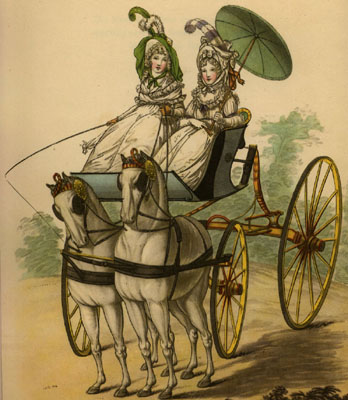 Figures 19 and 20.
Figures 19 and 20.
Dresses of August 1794 from The Gallery of Fashion | |
| Previous Issue | Next Issue |
This is the fifth issue of the journal, Vol. I, no. 5. The volumes run from April to March. In this issue, there are two plates and two pages of description. Plate one features figure 19 and 20 and is shown below in greyscale. Plate 2 features figures 21 and 22 and is shown below in color.
| FIG. XIX |
| A Lady in mourning.--Head- dress: composed of six yards of black and white cross-striped crape-gauze, formed into a twisted turban, and finishing behind in a long veil, trimmed with a fringe of bugles. The toupee and side curls lightly frizzed and intermixed with the turban; the hair behind thrown into ringlets. One white ostrich and one black heron feather placed on the right side. Robe and petticoat of black taffeta; long sleeves, with short loose sleeves over them; the whole trimmed with bugle fringe. Crape handkerchief with in the robe. One string of large black beads round the neck, and black ear-rings of the same. Black gloves, fan, and shoes. |
| FIG. XX |
| A Lady in half- mourning.--Head-dress: white chip hat bound with black, and trimmed with a piece of black silk; two black feathers placed on the right side, near the front. The toupee combed straight, and the hair behind in ringlets. Pierrot and petticoat of clear white lawn; short sleeves, with full half sleeves, trimmed with narrow love riband: the petticoat embroidered and trimmed in black. Full plaiting of lawn round the neck, tied in the front with love riband. Sash of broad love riband tied on the left side. Two strings of black beads round the neck. Ear-rings of the same. Grey gloves. White shoes, trimmed with black. |
 Figures 19 and 20.
Figures 19 and 20.

Morning Dresses. (August, 1794). The plate description begins "Two Ladies, en neglige, taking an airing in a phaeton." These ladies are out for a morning drive in a high-perch phaeton. They wear plain calico morning dresses and ribbon and feather-trimmed bonnets. Note the striped dye on one of the ostrich feathers. The high-perch phaeton was extremely dangerous--no doubt one reason why it was so fashionable! It was also very expensive to keep, so only the most wealthy and daring lady would be seen out in a London park tooling in such a vehicle. The original description of the left figure reads: "Headdress: white stamp- paper hat, trimmed with a green riband and tied down with the same. One green and one yellow feather placed on the left side. Green gauze veil. The hair in small curls; plain chignon. Plain calico morning dress with long sleeves; the petticoat trimmed with a narrow flounce. Plain lawn handkerchief, green sash, lawn cloak trimmed with lace and tied behind, york tan gloves, yellow shoes." The original description of the right figure reads: "Headdress: straw-coloured hat, trimmed with orange and purple ribands, and a white lawn handkerchief, embroidered in lilac, tied down with a white riband. One lilac and white cross-striped large ostrich feather on the left side, the hair in light curls and hanging down in ringlets behind, bound with a half-handkerchief tied into a large bow in the front. Chemise of spotted muslin, trimmed with a double plaiting of broad lace about the waist, tied in front by a lilac riband, short loose sleeves, tied in the middle with the same riband. Lilac-coloured sash tied behind, jonquille-coloured gloves and shoes."
To Return to Main Page of The Gallery of Fashion